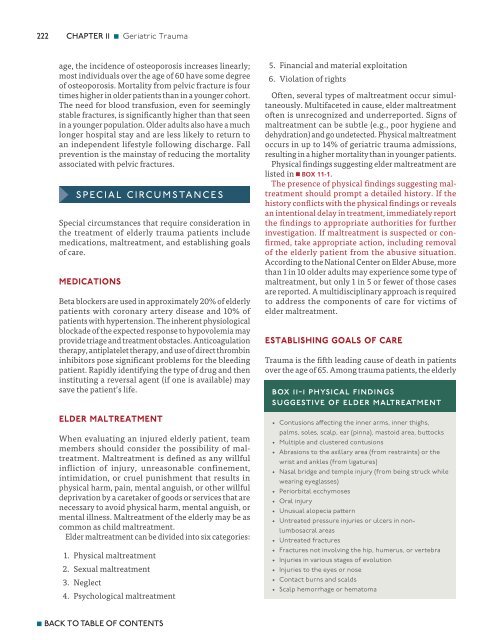Advanced Trauma Life Support ATLS Student Course Manual 2018
You also want an ePaper? Increase the reach of your titles
YUMPU automatically turns print PDFs into web optimized ePapers that Google loves.
222<br />
CHAPTER 11 n Geriatric <strong>Trauma</strong><br />
age, the incidence of osteoporosis increases linearly;<br />
most individuals over the age of 60 have some degree<br />
of osteoporosis. Mortality from pelvic fracture is four<br />
times higher in older patients than in a younger cohort.<br />
The need for blood transfusion, even for seemingly<br />
stable fractures, is significantly higher than that seen<br />
in a younger population. Older adults also have a much<br />
longer hospital stay and are less likely to return to<br />
an independent lifestyle following discharge. Fall<br />
prevention is the mainstay of reducing the mortality<br />
associated with pelvic fractures.<br />
Special circumstANces<br />
Special circumstances that require consideration in<br />
the treatment of elderly trauma patients include<br />
medications, maltreatment, and establishing goals<br />
of care.<br />
Medications<br />
Beta blockers are used in approximately 20% of elderly<br />
patients with coronary artery disease and 10% of<br />
patients with hypertension. The inherent physiological<br />
blockade of the expected response to hypovolemia may<br />
provide triage and treatment obstacles. Anticoagulation<br />
therapy, antiplatelet therapy, and use of direct thrombin<br />
inhibitors pose significant problems for the bleeding<br />
patient. Rapidly identifying the type of drug and then<br />
instituting a reversal agent (if one is available) may<br />
save the patient’s life.<br />
Elder Maltreatment<br />
When evaluating an injured elderly patient, team<br />
members should consider the possibility of maltreatment.<br />
Maltreatment is defined as any willful<br />
infliction of injury, unreasonable confinement,<br />
intimidation, or cruel punishment that results in<br />
physical harm, pain, mental anguish, or other willful<br />
deprivation by a caretaker of goods or services that are<br />
necessary to avoid physical harm, mental anguish, or<br />
mental illness. Maltreatment of the elderly may be as<br />
common as child maltreatment.<br />
Elder maltreatment can be divided into six categories:<br />
1. Physical maltreatment<br />
2. Sexual maltreatment<br />
3. Neglect<br />
4. Psychological maltreatment<br />
5. Financial and material exploitation<br />
6. Violation of rights<br />
Often, several types of maltreatment occur simultaneously.<br />
Multifaceted in cause, elder maltreatment<br />
often is unrecognized and underreported. Signs of<br />
maltreatment can be subtle (e.g., poor hygiene and<br />
dehydration) and go undetected. Physical maltreatment<br />
occurs in up to 14% of geriatric trauma admissions,<br />
resulting in a higher mortality than in younger patients.<br />
Physical findings suggesting elder maltreatment are<br />
listed in n BOX 11-1.<br />
The presence of physical findings suggesting maltreatment<br />
should prompt a detailed history. If the<br />
history conflicts with the physical findings or reveals<br />
an intentional delay in treatment, immediately report<br />
the findings to appropriate authorities for further<br />
investigation. If maltreatment is suspected or confirmed,<br />
take appropriate action, including removal<br />
of the elderly patient from the abusive situation.<br />
According to the National Center on Elder Abuse, more<br />
than 1 in 10 older adults may experience some type of<br />
maltreatment, but only 1 in 5 or fewer of those cases<br />
are reported. A multidisciplinary approach is required<br />
to address the components of care for victims of<br />
elder maltreatment.<br />
Establishing Goals of Care<br />
<strong>Trauma</strong> is the fifth leading cause of death in patients<br />
over the age of 65. Among trauma patients, the elderly<br />
box 11-1 physical findings<br />
suggestive of elder maltreatment<br />
• Contusions affecting the inner arms, inner thighs,<br />
palms, soles, scalp, ear (pinna), mastoid area, buttocks<br />
• Multiple and clustered contusions<br />
• Abrasions to the axillary area (from restraints) or the<br />
wrist and ankles (from ligatures)<br />
• Nasal bridge and temple injury (from being struck while<br />
wearing eyeglasses)<br />
• Periorbital ecchymoses<br />
• Oral injury<br />
• Unusual alopecia pattern<br />
• Untreated pressure injuries or ulcers in nonlumbosacral<br />
areas<br />
• Untreated fractures<br />
• Fractures not involving the hip, humerus, or vertebra<br />
• Injuries in various stages of evolution<br />
• Injuries to the eyes or nose<br />
• Contact burns and scalds<br />
• Scalp hemorrhage or hematoma<br />
n BACK TO TABLE OF CONTENTS

















